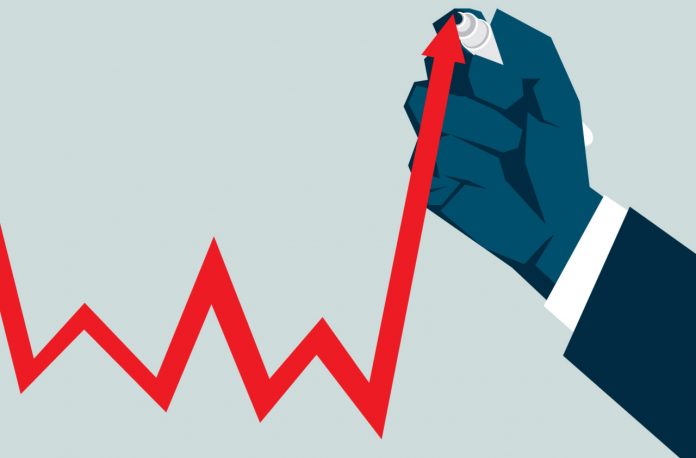With the increase in petroleum prices, the country’s Consumer Price Index (CPI) inflation increased by 4.9 per cent year-on-year (YoY) basis in March 2017, as compared to 4.2 per cent in the previous month or 3.9 per cent in March 2016.
On a month-on-month basis, it increased by 0.8 per cent in March 2017, as compared to an increase of 0.3 per cent in the previous month and an increase of 0.1 per cent in March 2016, the data revealed by Pakistan Bureau of Statistic (PBS) said here on Monday.
“Country’s inflation is linked with petroleum prices and in the last three months petroleum prices have been increased by Rs 8 throughout the country,” the analyst said. The food inflation is also increased slightly only because of petroleum prices and export to Afghanistan, he added.
The analyst said, “Inflation to remain in the range of 4.0-4.5 per cent on the back of lower than anticipated inflation in full year.” The average inflation clocked in at 4.9 per cent during the first nine months, lower than the earlier projections due to the smooth supply of perishable items, stable exchange rate, and government’s absorption of the impact of higher international oil prices.
He further said that the current trends suggest that the actual inflation would be lower than the actual target of 6 per cent in 2016-17.”
“The ministry of finance is persistently increasing the petroleum prices in every 15 days instead of absorbing and it would directly hit the core inflation in the coming months,” another analyst said. “We are looking at an inflation above 4.5 per cent in March and April 2017, only because of higher petroleum prices in the international market.”
Core inflation measured by non-food non-energy CPI (Core NFNE) increased by 5.3 per cent on a YoY basis in March 2017 as compared to increase of 5.3 per cent in the previous month and 4.7 per cent in March 2016. On (MoM) basis, it increased by 0.1 per cent in March 2017 as compared to the increase of 0.2 per cent in the previous month, and an increase of 0.2 per cent in the corresponding month of last year March 2016.
Core inflation, measured by 20 per cent weighted trimmed mean CPI (Core Trimmed) increased by 4.5 per cent on (YoY) basis in March 2017 as compared to 4.1 per cent in the previous month and by 3.8 per cent in March 2016. On (MoM) basis, it increased by 0.2 per cent in March 2017 as compared to an increase of 0.2 per cent in the previous SPI inflation on YoY increased by 1.1 per cent in February 2017 as compared to an increase of 0.4 per cent a month earlier and an increase of 3.6 per cent in February 2016. On a MoM basis, it increased by 0.2 per cent in February 2017 as compared to a decrease of 0.8 per cent a month earlier and a decrease of 0.5 per cent in February 2016.
Wholesale Price Index (WPI) inflation on YoY basis increased by 6.4 per cent in March 2017, as compared to an increase of 5.3 per cent a month earlier and an increase of 0.2 per cent in March 2016. WPI inflation on MoM basis increased by 0.7 per cent in March 2017 as compared to an increase of 0.5 per cent a month earlier and a decrease of 0.4 per cent in the corresponding month of last year i.e. March 2016.
Sensitive Price Index (SPI) inflation on YoY increased by 3.1 per cent in March 2017 as compared to an increase of 1.1 per cent a month earlier and an increase of 3.5 per cent in March 2016. On a MoM basis, it increased by 1.8 per cent in March 2017 as compared to an increase of 0.2 per cent a month earlier and a decrease of 0.2 per cent in March 2016.
Based on our 12 months moving average inflation forecast, the Taurus securities report said that the Monetary Policy Committee (MPC) is to consider the policy rate hike in 2nd half 2017 where we do not rule out extended delay based on (i) 2018 being the election year, and (ii) the fact that the committee may resort to negative real interest rate spread to boost GDP which was last seen in 2005.
Month-on-month, the prices increased of food item commodities are Tomatoes (68.43 per cent ), Chicken (21.6 per cent), Onion (18.16 per cent), Potatoes (15.48 per cent), Fresh Fruits (12.52 per cent), and Tea (5.1 per cent).
Decreased: Eggs (21.34 percent), Pulse Gram (8.06 per cent), Besan (4.49 per cent), Sugar (4.39 per cent), Pulse Masoor (4.16 per cent), Gram whole (4.02 per cent), Pulse Moong (3.66 per cent), Pulse Mash (3.54 per cent), and Gur (2.35 per cent).
The analyst said that prices of general food items tend to build up as Ramadan approaches and we expect 4Q 2016-17 CPI to average at 5.4 per cent YoY that would lead 2016-17 inflation to 4.3 per cent YoY in line with SBP’s forecast of ‘close’ to 4.0 per cent. Consequently, real interest rate spread would compress to 145 basis points by 2016-17 end vs. average 6-year spread of 160 basis points.




